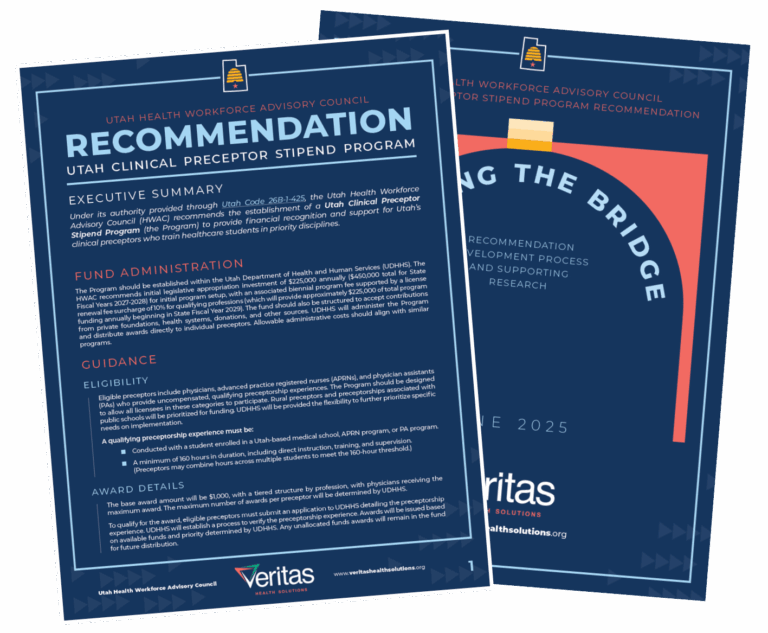
Bridging the Gap
Clinical Preceptors for Physicians and Advanced Practice Registered Nurses in Utah

A brief summary of the clinical preceptor issue and recommendations to strengthen the physician and APRN pipeline in the Beehive State
BACKGROUND
Clinical training is an essential component of preparing a state’s health workforce. Members of the Utah Health Workforce Advisory Council (HWAC) have consistently identified clinical preceptor shortages as one of the most pressing challenges impacting health professions education and workforce development. This issue has also garnered prior interest from state legislators (as reflected by the introduction of House Bill 386 in the 2023 session). In direct response, the HWAC prioritized the examination of Utah’s clinical preceptors landscape and the development of actionable recommendations as a central focus in its 2024 Action Plan.
Under the authority of the Health Workforce Act and in partnership between the HWAC and Utah Health Workforce Information Center (HWIC), the Department of Commerce’s Division of Professional Licensing began collecting supplemental workforce data from Utah’s licensed physicians and advanced practice registered nurses (APRNs) as the first professions prioritized for collection and analysis (due to priority establishment by the Legislature and in alignment with professional renewal timelines). The data captured from these professionals during license renewal was prioritized by the HWAC to include professionals’ self-reported participation as a preceptor.
Although the HWAC recognizes that a wide range of health professions report difficulties securing sufficient preceptorship opportunities, clearly defining the scope of the study was essential to ensure meaningful analysis and develop feasible recommendations. Therefore, given the data that were available for Utah physicians and APRNs, the initial clinical preceptor study and associated recommendations was focused on these professions. However, the methodology and approach lay the groundwork for expansion to include an assessment and additional professions in future years, if prioritized by the HWAC or other entities.
This document outlines the findings from data analyses and stakeholder perspectives to contribute to knowledge on the clinical preceptor landscape within the state of Utah, outlining training needs; current capacity; and perspectives from practicing professionals (both preceptors and non-preceptors), training programs, and other key stakeholders. Accompanying documents have been prepared to outline details about the HWAC’s Clinical Preceptor Subcommittee establishment, associated policy research, recommendation development process, and presentation of the HWAC recommendation.
WHAT IS THE CURRENT NEED FOR PRECEPTORS?
Clinical training is a core component of each physician and APRN’s training period. Although the specifics of clinical training requirements differ for each profession and program, gross numbers of program graduates provide general information as to how many clinical preceptors are required.



ADDITIONAL DOCUMENTATION
Development Process and Supporting Research
Long-form technical document laying out all of the details of the process.
HWAC Recommendation Two-Pager
Abridged document with the HWAC Recommendation.
UTAH’S PRECEPTOR BOTTLENECK
Utah’s healthcare workforce development faces a critical bottleneck in the form of clinical preceptor shortages that threaten the state’s ability to train the next generation of healthcare professionals. This comprehensive analysis reveals a complex landscape where demand for clinical training opportunities consistently outpaces supply, threatening the availability of clinical training experiences to meet students’ needs for graduation and practice.
The data paints a concerning picture: the growing number of healthcare training programs will place unprecedented strain on an already stretched preceptor workforce. The challenge is particularly acute in primary care specialties and rural communities, precisely the areas where Utah most needs to strengthen its healthcare infrastructure.
The stakes are significant. Utah’s ability to meet its residents’ healthcare needs in the coming decades will be substantially influenced by the actions taken today to strengthen and expand clinical preceptor capacity. The HWAC’s work represents a crucial step toward securing Utah’s healthcare workforce future and ensuring that all residents have access to high-quality care delivered by well-trained professionals who are prepared to serve their communities.

Report design by Zachary Ammerman
Veritas Health Solutions
INQUIRIES?
You can get in touch with us by filling out the form on our Contact Us page.
STAY IN TOUCH
Keep up to date by following us on LinkedIn.

